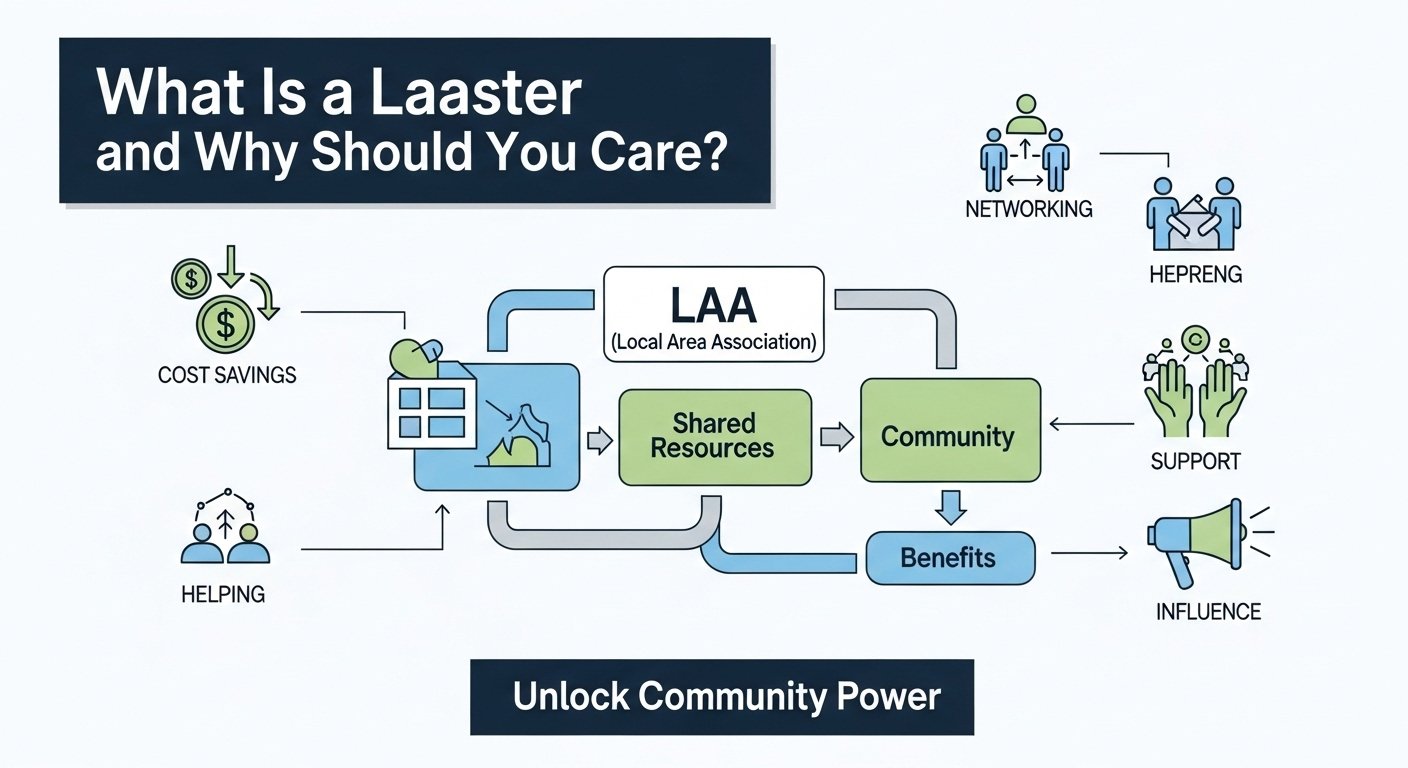Have you ever heard the word laaster and wondered what it means? You’re not alone! It sounds like a fancy word, but the meaning is simple and helpful. A laaster is something that helps carry, move, or lift heavy things more easily. It could be a tool, a device, or even a type of equipment used in homes, schools, warehouses, or construction sites. People use laasters to keep their bodies safe, save energy, and finish tasks faster. Whether you’re moving furniture, delivering packages, or organizing a garage, knowing how to use a laaster can make your life easier. In this guide, we’re going to explore what a laaster is, where you might use it, and how it can help you in ways you didn’t even think of. So grab your seat, and let’s get ready to dive into the world of laasters—because they just might become your new best helper!
Understanding the Meaning of Laaster
Let’s begin with the basics—what exactly is a laaster? The word isn’t used by everyone, but it usually refers to a tool that helps with lifting or carrying heavy objects. That means instead of using your hands and back (and possibly hurting yourself), you use the laaster. Think of a laaster like a strong friend who’s always there to help. It could be a hand truck, a dolly, a lift assist machine, or even a type of harness. There’s no single shape or style. What’s most important is the job it does—making heavy things feel light. Laasters are tools of convenience and control. They can be small and simple, like something you use at home, or very big and strong, like those used at shipping yards or construction sites. The purpose is always the same: to make hard work easier, safer, and faster.
Types of Laasters You Can Find Today
Did you know there are different kinds of laasters for different jobs? It’s true! They come in many shapes and sizes to match your needs. There are manual laasters, like dollies or trolleys, usually pushed by hand. These are common in homes, schools, and small shops. Then we have electric laasters, which are powered by batteries and great for heavier loads. These are used in bigger workplaces like factories and warehouses. Some companies also use hydraulic laasters that use liquid pressure to lift really heavy stuff. These are often used in construction and mechanics. Finally, there are wearable laasters like support harnesses that help workers lift without hurting their backs. Whether big or small, each type of laaster helps with safety and efficiency. The right one depends on your situation.
How a Laaster Works
So how does a laaster do its magic? It’s all about using smart design to shift weight and add support. A basic laaster, like a dolly, puts weight on wheels so you don’t carry it fully. That saves your arms and back from stress. An electric laaster uses battery power to lift or roll loads—no need to push or pull hard. Hydraulic models multiply your strength by using pressurized fluid to raise heavy items like car engines or pallets. Each version of a laaster is made to reduce human effort and increase control. Some laasters have handles, bars, foot pedals, or levers to help you guide or hold them in place. Others even come with safety brakes. It’s like a strong assistant that makes it easier to work smarter, not harder.
Where You’ll Find Laasters in Everyday Life
You might not notice, but laasters are everywhere! They’re often used behind the scenes to get important jobs done. In warehouses, workers use laasters to organize large boxes and deliveries. In hospitals, medical staff use them to move equipment safely. Delivery workers roll packages on wheeled laasters daily. Supermarket staff use them to restock shelves. Even in schools, janitors might use a laaster to carry cleaning supplies or furniture. Construction workers almost always have access to one. And believe it or not, movers use laasters every day when helping families switch homes. So even if you’ve never used one, someone near you probably has. That’s how important laasters are in making the world run smoothly.
Benefits of Using a Laaster
Using a laaster comes with many benefits. First and foremost, it helps protect your body. Lifting heavy items can lead to back pain, strained muscles, or even serious injuries. A laaster takes on most of the weight, giving you safety and support. Second, using a laaster saves time. Instead of making multiple trips, you can carry more in one go. Third, it increases productivity. Workers who use laasters often get more done in less time. Whether you’re moving at work or at home, a laaster can help you feel more confident. It’s also great for anyone with physical limitations or health concerns. Even kids or older adults can safely use basic laasters under supervision. Best of all, many laasters are lightweight and easy to store, ready to help when needed.
How to Choose the Right Laaster for You
Choosing the best laaster depends on your task. First, ask yourself: what will I lift? If it’s lightweight stuff around the house—like boxes or small furniture—a simple manual laaster will work just fine. If you’re working in a warehouse or large area, go with an electric or hydraulic laaster. Think about the ground too. Will you roll it on soft carpet or rough pavement? Some laasters come with wheels made just for smooth floors, while others have tough tires for rough terrain. Also consider how often you’ll use it. If it’s just for a one-time job, maybe renting is smarter than buying. Be sure to check the weight limits and always choose a model that can carry a bit more than what you expect to lift. Taking the time to pick the right laaster can save you a lot of stress and effort.
Safety First: Using a Laaster the Right Way
A laaster is a helpful tool, but safety still matters. First, always check your laaster before using it. Look for cracked wheels, loose screws, or broken parts. If anything seems off, fix it first. When loading, place the item in the center so the weight is balanced. Never overload it. Each laaster has a weight limit—stick to it. Always push it rather than pull. This gives you better control and reduces the risk of falling. Wear gloves for better grip, especially if your hands get sweaty. If your laaster is electric or hydraulic, make sure it’s fully charged and on a safe surface. Also, store your laaster properly in a dry, safe place when not in use. Following these simple safety tips helps you enjoy all the benefits of your laaster without any trouble.
Real-Life Uses of Laasters Explained
Let’s take a look at real people who’ve used laasters and changed their routines. Sarah works in a school. She used to carry boxes of classroom materials alone. Now, she uses a small foldable laaster and says she finishes work in half the time—with no back pain! Mike, a delivery driver, loads and unloads 100 packages a day. His electric laaster does most of the work. His energy levels improved, and he avoids injuries. Even Grandma Lucy uses a lightweight trolley-style laaster to move her gardening supplies. Laasters aren’t only for workers or professionals. They’re for anyone who wants to make lifting easier, faster, and safer.
Laaster vs. Dolly: What’s the Difference?
Many people ask, “Isn’t a laaster just another name for a dolly?” Good question! While they are similar, there’s a difference. A dolly is usually a small, flat platform with four wheels. You place boxes or items on it and push. It’s a type of laaster. But the term “laaster” is much broader. It can include dollies, trolleys, hydraulic lifts, and powered carts. Dollies are great for basic use. Laasters include heavy-duty options that support more weight or come with motors. So yes, all dollies are laasters, but not all laasters are dollies. Think of a laaster as the parent category, with dollies being one of the children under it.
The Cost of Laasters: Are They Affordable?
Wondering how much a laaster costs? Don’t worry—there’s something for every budget. Small manual laasters can cost between $30 to $80. These are good for home use or light office jobs. Heavier-duty laasters like electric models start around $200 and can go up to $1,000 or more. Industrial-grade versions used in shipping yards or factories may be even pricier. If you’re not ready to buy, renting is a smart option. Many home improvement stores rent laasters by the hour or day. This way, you get what you need without paying the full price. Always consider your use before spending money. A one-time move might not need a full purchase—but ongoing jobs definitely do.
Caring for Your Laaster: Easy Maintenance Tips
If you want your laaster to last a long time, a little care goes a long way. After each use, wipe it down—especially if it was used outdoors or in dirty places. Check the wheels to make sure they spin smoothly and aren’t stuck with lint or dirt. Tighten any screws or handles that feel a bit loose. If your laaster has batteries, charge them after use and never leave them in extreme heat or cold. Lubricate the joints or hinges once in a while to keep them moving smoothly. Store your laaster in a dry area to prevent rust. With just a few simple checks and habits, your laaster can stay strong and ready for years of heavy lifting.
The Future of Laasters: Smarter Tools Are Coming
Technology is changing how we work, and the laaster world is no exception. New laasters are being made with smart features. Some can detect when your load is too heavy and alert you with sounds or lights. Others have auto-stop wheels for added safety on sloped floors. Some smart factory laasters are even robotic—they follow workers and carry loads without needing to be pushed. App-connected laasters can track your usage, charging times, or even offer maintenance advice. These upgrades make laasters safer, smarter, and more fun to use. As tech continues to grow, expect future laasters to be even more helpful and user-friendly, whether for professional or personal use.
FAQs
Q1: What does a laaster do?
A laaster helps you carry or move heavy things with ease. It takes the weight off your hands.
Q2: Who should use a laaster?
Anyone who moves heavy things—like office workers, movers, warehouse staff, or even homeowners doing DIY.
Q3: Is a dolly the same as a laaster?
A dolly is a type of laaster, but not all laasters are dollies. Some are powered or more complex.
Q4: Are laasters safe for kids or older adults?
Yes, simple laasters can be used safely under supervision. Just choose lighter models made for home use.
Q5: Can I rent a laaster if I don’t want to buy one?
Absolutely! Many stores offer rental options if you only need it for a short project.
Q6: How long does a laaster last?
With proper care, even a basic laaster can last for several years or longer, depending on usage.
Conclusion
Heavy lifting shouldn’t be back-breaking or frustrating. That’s why having the right laaster can change your life. Whether you’re working at home, in a school, a store, a construction site, or a warehouse, this smart tool adds a helping hand every time. You save time, protect your body, and get more done with less stress. Best of all, laasters come in so many types that anyone can find one that works perfectly for their task. So don’t wait until you’re struggling with that next heavy box, stack of books, or piece of furniture. Add a laaster to your toolkit and discover just how much easier your day can be. Ready to shop for the perfect laaster? Start exploring your options today—you’ll be glad you did!





